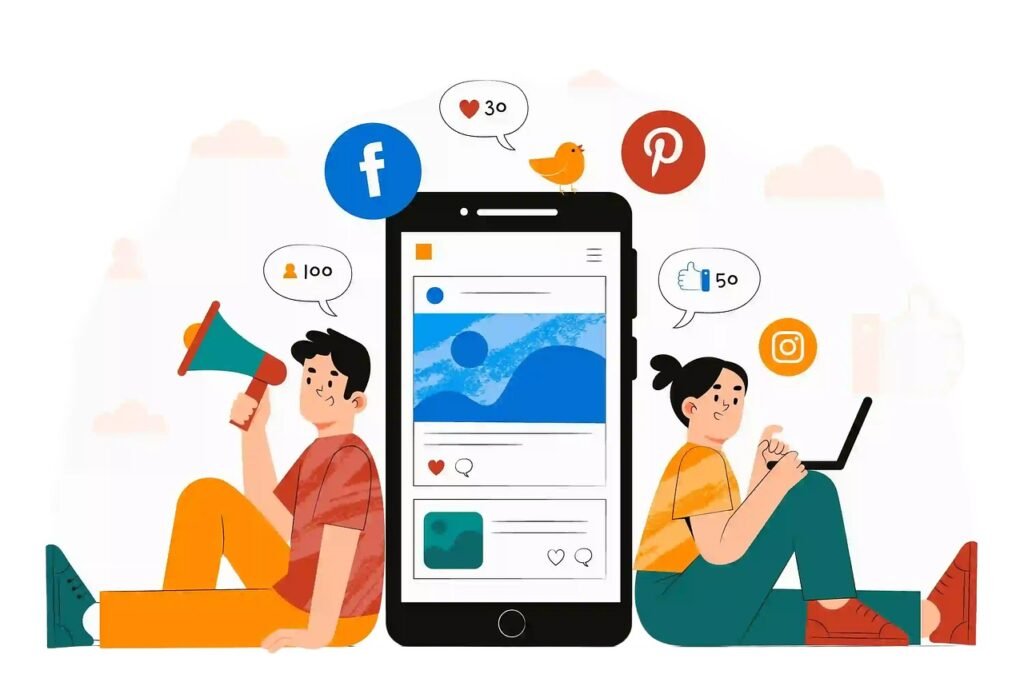- 1. How Has Social Media Marketing Increased Business Exposure in 2024?
- 2. What Impact Has Social Media Had on Sales?
- 3. How Much Are Businesses Spending on Social Media Ads in 2024?
- 4. What Role Does Instagram Play in Social Media Ad Revenue?
- 5. How Influential Are Social Media Influencers?
- 6. Why Is Video Content More Likely to Be Shared on Social Media?
- 7. How Prevalent Is Video as a Marketing Tool on Social Media?
- 8. How Do Consumers Prefer to Learn About Products on Social Media?
- 9. How Much Time Do Social Media Users Spend Online Daily?
- 10. How Common Is Paid Social Media Advertising?
- 11. How Effective Is LinkedIn for B2B Social Media Marketing?
- 12. How Do Consumers Discover New Products on Instagram?
- 13. How Popular Is Facebook for Social Media Advertising?
- 14. How Do Consumers Perceive Brands That Interact on Social Media?
- 15. What Are Consumer Expectations for Response Times on Social Media?
- 16. How Fast Is TikTok Growing?
- 17. How Responsive Are Brands to Social Media Messages?
- 18. How Large Is Facebook’s User Base in 2024?
- 19. Are Marketers Increasing Their Social Media Budgets?
- 20. How Effective Is User-Generated Content on Social Media?
- 21. How Many Social Media Users Follow Brands?
- 22. How Does Social Media Marketing Affect Brand Loyalty?
- 23. How Effective Is Pinterest for Driving Traffic to Shopping Sites?
- 24. How Significant Is Social Media Referral Traffic?
- 25. How Active Are Twitter Users?
- 26. How Do Social Media Posts Impact Purchase Decisions?
- 27. How Does Social Media Activity Affect Customer Satisfaction?
- 28. How Do Users Access Social Media Platforms?
- 29. How Often Do Facebook Users Engage with Ads?
- 30. What Is the User Base of Snapchat in 2024?
- We got all the latest Marketing Stats here:
Welcome to the ultimate guide on the state of social media marketing in 2024! If you’re a marketer, business owner, or simply curious about the latest trends and statistics in the social media landscape, you’re in the right place. This article will delve into the most important statistics that every marketer should know this year. From ad spending to user behavior, we’ve got you covered with the latest data and insights to help you stay ahead of the game.
1. How Has Social Media Marketing Increased Business Exposure in 2024?

In 2024, 90% of marketers report that social media marketing has significantly increased their business exposure. This impressive figure highlights the power of social media in reaching wider audiences.
With platforms like Instagram, Facebook, and TikTok continually growing, businesses can now connect with millions of potential customers around the globe. The increase in business exposure is attributed to the engaging content, targeted ads, and the ability to interact directly with consumers, creating a more personalized and engaging experience.
2. What Impact Has Social Media Had on Sales?
A staggering 78% of marketers have reported an increase in sales due to their social media efforts. This statistic underscores the importance of having a robust social media presence.
Platforms such as Instagram Shopping and Facebook Marketplace have made it easier than ever for consumers to purchase products directly from social media. By leveraging targeted ads and engaging content, businesses can convert followers into loyal customers, driving sales and growth.
3. How Much Are Businesses Spending on Social Media Ads in 2024?
Social media ad spending is projected to reach an astonishing $134 billion in 2024. This growth reflects the increasing reliance on social media advertising as a key component of marketing strategies.
Companies are investing more in social media ads to reach their target audience, boost brand awareness, and drive sales. With advanced targeting options and the ability to measure ROI accurately, social media advertising offers an attractive and effective marketing channel.
4. What Role Does Instagram Play in Social Media Ad Revenue?
Instagram is set to account for 30% of social media ad revenue in 2024. Known for its highly visual and engaging content, Instagram has become a favorite among marketers.
Features like Stories, Reels, and Shopping have provided brands with innovative ways to showcase their products and connect with audiences. Instagram’s ability to drive engagement and conversions makes it a vital platform for any social media marketing strategy.
5. How Influential Are Social Media Influencers?
In 2024, 67% of consumers say that social media influencers significantly impact their purchasing decisions. Influencers have become powerful brand advocates, leveraging their large followings to promote products and services.
By partnering with influencers, brands can tap into their established trust and credibility, reaching new audiences and driving sales. The authentic and relatable content created by influencers resonates well with consumers, making influencer marketing a crucial tactic.
6. Why Is Video Content More Likely to Be Shared on Social Media?
Video content is 40% more likely to be shared on social media than other types of content. Videos are engaging, easy to consume, and can convey a lot of information in a short amount of time.
Platforms like TikTok and Instagram Reels have popularized short-form videos, encouraging users to create and share content. Marketers are increasingly using video to capture attention, tell compelling stories, and drive engagement on social media.
7. How Prevalent Is Video as a Marketing Tool on Social Media?
85% of businesses are using video as a marketing tool on social media in 2024. Video content has proven to be highly effective in engaging audiences and driving conversions.
From product demos to customer testimonials, videos can showcase products and services in a dynamic and engaging way. The popularity of video content on platforms like YouTube, Instagram, and TikTok has made it an essential part of any social media marketing strategy.
8. How Do Consumers Prefer to Learn About Products on Social Media?
70% of consumers prefer to learn about products through social media posts rather than traditional ads. This preference indicates a shift towards more authentic and engaging content.
Consumers trust recommendations from their social networks and appreciate the interactive nature of social media. Brands that create informative and visually appealing posts can effectively capture the attention and interest of their target audience.
9. How Much Time Do Social Media Users Spend Online Daily?
The average social media user spends 2 hours and 25 minutes on social media each day in 2024. This significant amount of time provides ample opportunities for brands to connect with their audience.
By consistently posting engaging content, interacting with followers, and running targeted ads, businesses can maximize their reach and influence on social media. Understanding user behavior and preferences is key to creating a successful social media strategy.
10. How Common Is Paid Social Media Advertising?

72% of marketers use paid social media advertising in 2024. Paid ads offer a way to reach a larger and more targeted audience. Platforms like Facebook, Instagram, and LinkedIn provide advanced targeting options, allowing businesses to reach users based on demographics, interests, and behaviors.
Paid advertising can boost visibility, drive traffic, and increase conversions, making it an essential tool in a marketer’s arsenal.
11. How Effective Is LinkedIn for B2B Social Media Marketing?
LinkedIn generates 80% of B2B social media leads, making it the top platform for business-to-business marketing. LinkedIn’s professional network is ideal for reaching decision-makers and industry leaders.
Features like LinkedIn Ads, Sponsored Content, and InMail allow businesses to target specific industries, job titles, and company sizes. By sharing valuable content and engaging with the community, businesses can establish thought leadership and generate high-quality leads.
12. How Do Consumers Discover New Products on Instagram?
60% of users say they discover new products on Instagram. Instagram’s visual-centric platform makes it perfect for showcasing products. Features like Stories, Explore, and Shopping tags make it easy for users to find and purchase new products.
Brands can leverage influencer partnerships, user-generated content, and visually appealing posts to attract and engage potential customers.
13. How Popular Is Facebook for Social Media Advertising?
93% of social media advertisers use Facebook, highlighting its dominance in the advertising space. Facebook’s vast user base and sophisticated targeting options make it an attractive platform for advertisers.
With tools like Facebook Ads Manager, businesses can create highly targeted campaigns to reach their desired audience. The platform’s ability to drive engagement and conversions makes it a staple in social media marketing strategies.
14. How Do Consumers Perceive Brands That Interact on Social Media?
81% of people have a better perception of brands when they interact with them on social media. Engaging with followers through comments, messages, and posts can build trust and loyalty.
Brands that respond to customer inquiries, share user-generated content, and participate in conversations create a positive and relatable image. This interaction fosters a sense of community and strengthens the relationship between the brand and its audience.
15. What Are Consumer Expectations for Response Times on Social Media?
52% of consumers expect brands to respond to their inquiries on social media within an hour. This expectation emphasizes the importance of timely and effective communication.
Brands that respond quickly to questions, complaints, and comments can enhance customer satisfaction and loyalty. Implementing a responsive customer service strategy on social media is crucial for maintaining a positive brand image.

16. How Fast Is TikTok Growing?
TikTok is the fastest-growing social media platform, with a 105% user growth rate in 2023. Its rapid growth continues into 2024, making it a key platform for marketers. TikTok’s short-form video format is highly engaging and has captured the attention of a younger audience.
Brands can leverage trends, challenges, and influencer partnerships to create viral content and reach a large audience quickly.
17. How Responsive Are Brands to Social Media Messages?
Despite the importance of interaction, 89% of social media messages to brands go unanswered. This gap presents an opportunity for brands to stand out by improving their responsiveness.
Businesses that actively monitor and respond to messages can build stronger relationships with their customers and enhance their brand reputation. Implementing a dedicated social media management team can help address this issue.
18. How Large Is Facebook’s User Base in 2024?
Facebook has 2.96 billion monthly active users as of 2024, maintaining its position as the largest social media platform. This extensive user base provides businesses with a vast audience to reach.
By leveraging Facebook’s advertising tools and engaging content, brands can connect with a diverse and global audience. Understanding the platform’s dynamics and user behavior is essential for effective marketing.
19. Are Marketers Increasing Their Social Media Budgets?
68% of marketers plan to increase their social media marketing budget in 2024. This trend indicates a growing recognition of the importance of social media in marketing strategies.
Increased budgets allow for more comprehensive campaigns, higher-quality content, and advanced targeting options. Investing in social media can drive brand awareness, engagement, and sales, making it a critical component of any marketing plan.
20. How Effective Is User-Generated Content on Social Media?

User-generated content has a 4.5% higher conversion rate on social media compared to other types of content. This effectiveness is due to the authenticity and trust that user-generated content brings.
Consumers are more likely to trust and engage with content created by their peers. Brands can encourage customers to share their experiences and feature this content on their social media channels to boost credibility and drive conversions.
21. How Many Social Media Users Follow Brands?
58% of social media users follow at least one brand. This statistic highlights the importance of building a strong brand presence on social media. Followers are more likely to engage with and support brands they follow.
By creating engaging and valuable content, brands can attract and retain followers, fostering loyalty and encouraging repeat business.
22. How Does Social Media Marketing Affect Brand Loyalty?
Social media marketing efforts can increase brand loyalty by 53%. Engaging with customers, providing valuable content, and offering exclusive deals on social media can enhance customer loyalty. Brands that build a strong online community and consistently interact with their audience can create lasting relationships. This loyalty translates into repeat business and positive word-of-mouth marketing.
23. How Effective Is Pinterest for Driving Traffic to Shopping Sites?
Pinterest drives 33% more referral traffic to shopping sites than Facebook. Pinterest’s visual and discovery-oriented platform is ideal for showcasing products and driving traffic.
Features like Rich Pins and Shop the Look make it easy for users to explore and purchase products. Brands can leverage Pinterest’s unique format to reach users who are actively looking for inspiration and products.
24. How Significant Is Social Media Referral Traffic?
Social media referral traffic accounts for 31% of all website traffic. This statistic underscores the importance of having a strong social media presence to drive traffic to your website.
By sharing compelling content and engaging with followers, brands can attract visitors to their website. Social media platforms are essential channels for increasing online visibility and generating leads.
25. How Active Are Twitter Users?
Twitter users send 500 million tweets per day. This high level of activity makes Twitter a valuable platform for real-time engagement and marketing. Brands can use Twitter to share updates, participate in trending conversations, and connect with their audience.
The platform’s fast-paced nature requires timely and relevant content to capture attention and drive engagement.
26. How Do Social Media Posts Impact Purchase Decisions?

80% of consumers say social media posts, including user reviews, highly impact their purchase decisions. This influence highlights the power of social proof and recommendations on social media.
Brands can leverage customer testimonials, reviews, and user-generated content to build trust and encourage purchases. Positive interactions and content on social media can significantly influence consumer behavior.
27. How Does Social Media Activity Affect Customer Satisfaction?
Brands that are active on social media experience a 24% increase in customer satisfaction. Engaging with customers, addressing their concerns, and providing valuable content can enhance the overall customer experience.
Active social media presence allows brands to connect with their audience on a personal level, leading to higher satisfaction and loyalty.
28. How Do Users Access Social Media Platforms?
91% of social media users access social channels via mobile devices. This mobile-first approach highlights the importance of optimizing content for mobile viewing.
Brands need to ensure their social media posts, ads, and websites are mobile-friendly to provide a seamless experience. Mobile accessibility is crucial for reaching and engaging with the modern, on-the-go consumer.
29. How Often Do Facebook Users Engage with Ads?
The average Facebook user clicks on 12 ads per month. This engagement level indicates the effectiveness of Facebook’s targeted advertising.
By creating relevant and appealing ads, brands can capture users’ attention and drive traffic to their websites. Understanding user behavior and preferences is key to creating successful ad campaigns on Facebook.
30. What Is the User Base of Snapchat in 2024?
Snapchat’s daily active users are expected to reach 500 million by the end of 2024. Snapchat’s unique features like Stories, Filters, and Lenses offer creative ways for brands to engage with their audience.
The platform’s popularity among younger users makes it an attractive channel for reaching a specific demographic. Brands can use Snapchat to create fun and interactive content that resonates with their target audience.
We got all the latest Marketing Stats here:
Read next
- 23+ Ultimate Customer Support Tools to Empower Your Business
- Data Processing Agreement: An International Perspective
- Best SEO Tools in 11 Categories to Elevate Your SEO
- 51+ Outstanding Email Marketing Tools to Skyrocket ROI
- 11 Best SMS Marketing Software: Our Picks!






















Comments are closed.